Impact of Urban Water Conservation Policy
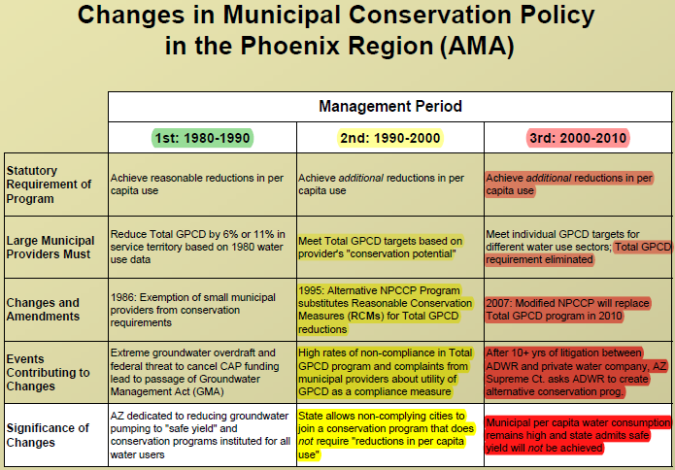
“In particular, the introduction of the Non Per Capita Conservation Program (NPCCP) in 1995 represents a shift from a performance-based program focused on reducing per capita water use to a prescriptive program emphasizing voluntary conservation. Further, demand efforts, which often fail to change water use behaviors.”
Water manager’s ongoing misrepresentation of Arizona’s Groundwater Management Act obfuscates water management reality in Arizona. Cities ONLY required to implement water conservation programs = no restrictions on water use and the ONLY reason Cities promote conservation.
“In particular, the introduction of the Non Per Capita Conservation Program (NPCCP) in 1995 represents a shift from a performance-based program focused on reducing per capita water use to a prescriptive program emphasizing voluntary conservation. Further, demand management programs in the region are predominately focused on education and outreach efforts, which often fail to change water use behaviors.” An Assessment of Municipal Water Conservation Policy in Greater Phoenix, Arizona, 1980-2007
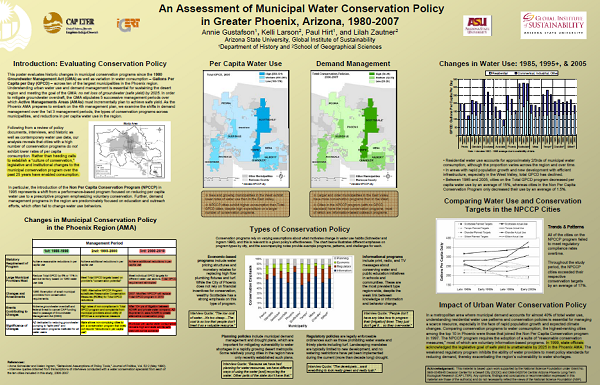
In a metropolitan area where municipal demand accounts for almost 40% of total water use, understanding residential water use patterns and conservation policies is essential for managing a scarce resource, especially in the face of rapid population growth and expected climate changes. Comparing conservation programs to water consumption, the highest-ranking cities among the top 10 in Phoenix were those that joined the Non Per Capita Conservation program in 1997. The NPCCP program requires the adoption of a suite of “reasonable conservation measures,” most of which are voluntary information-based programs. In 1999, state officials acknowledged the legislative goal of safe yield is unattainable by 2025 in the Phoenix AMA. The weakened regulatory program inhibits the ability of water providers to meet policy standards for reducing demand, thereby exacerbating the region’s vulnerability to water shortages.”
People often ask me why I bother to point out obfuscation by Arizona water managers – it’s because water managers often repeat carefully crafted misinformation (repeating press releases) about water management in Arizona.
“the only safe level of groundwater withdrawal would be that equal to the annual natural and incidental recharge. [A]DWR estimates this number for the three AMAs to be about 260,000 acre feet.” — Watering the Sun Corridor
“Safe-yield is defined as “a groundwater management goal which attempts to achieve and thereafter maintain a long-term balance between the annual amount of groundwater withdrawn in an active management area and the annual amount of natural and artificial groundwater recharge in the active management area.” A.R.S § 45-561(12).
If you search long and hard you will find this document from Arizona Department of Water Resources (ADWR) detailing continued depletion of aquifers in Active Management Areas (AMA). Or just click on the picture! – PDF
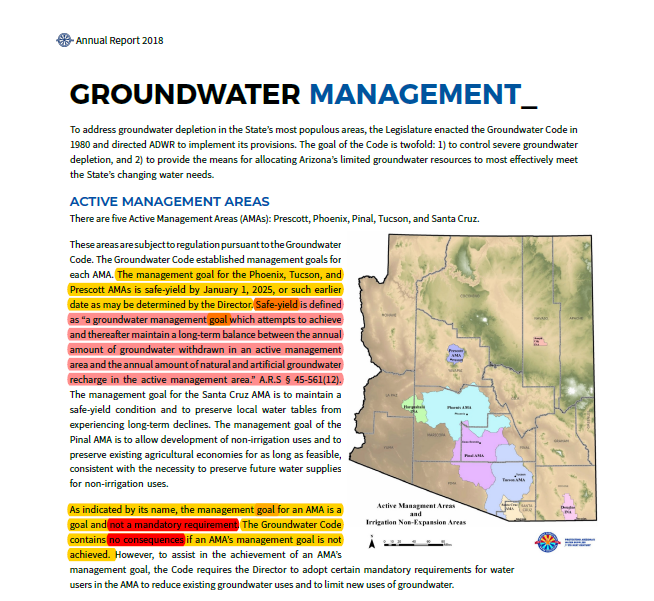
“There are five Active Management Areas (AMAs): Prescott, Phoenix, Pinal, Tucson, and Santa Cruz. These areas are subject to regulation pursuant to the Groundwater Code. The Groundwater Code established management goals for each AMA. The management goal for the Phoenix, Tucson, and Prescott AMAs is safe-yield by January 1, 2025, or such earlier date as may be determined by the Director. Safe-yield is defined as “a groundwater management goal which attempts to achieve and thereafter maintain a long-term balance between the annual amount of groundwater withdrawn in an active management area and the annual amount of natural and artificial groundwater recharge in the active management area.” A.R.S § 45-561(12) . . . As indicated by its name, the management goal for an AMA is a goal and not a mandatory requirement. The Groundwater Code contains no consequences if an AMA’s management goal is not achieved.”
Arizona water managers are focused and dedicated to supplying water for growth.
Water management and water conservation in Arizona are only promoted in ways that support growth.
The vaunted Arizona Groundwater Management Act (GMA) is ineffective; allowing water managers to continue to deplete Arizona’s water resources. The GMA is ineffective in controlling groundwater pumping because it only recommends “goals” rather than enforcing “mandatory requirements”; with no “consequences”!
Arizona Department of Water Resources (ADWR) obfuscates continued depletion of aquifers in the Phoenix AMA on their website.
“ALLOWABLE PUMPING & COMPLEX LEGAL STRUCTURE
Groundwater pumping is allowed under the Code, the management plans, and the AWS Rules through grandfathered rights, groundwater withdrawal permits, and service-area rights. Groundwater pumping creates a significant obstacle toward AMA efforts to achieve safe-yield. The burden of reducing mined groundwater does not apply proportionately to all water-using sectors. Since 1985, many of the Phoenix AMAs water users have reduced their use of groundwater and increased their use of renewable supplies. However, other water users in the AMA have continued or increased groundwater use, as allowed under current statutes and rules. The result has been that groundwater demand has not decreased, which affects progress towards achieving safe-yield.
Groundwater and non-groundwater sources are managed under different statutes with limited integration. In a rapidly growing AMA with multiple water sources, sound management of only one source may be problematic.
DEVELOPMENT PRESSURE
The Phoenix AMA is characterized by complex water use patterns and varying groundwater conditions. Municipal and industrial growth continues, while agricultural demand has declined moderately and will continue to do so. While the overall AMA water use has been fairly consistent for several years, certain areas within the AMA are experiencing water level declines from pumping that could restrict the potential for further growth and development. Other limited areas are exhibiting water-logging conditions. While recognizing that the goal of the Phoenix AMA is to achieve safe-yield on an AMA-wide basis, localized water management may be necessary to fully achieve the Code’s stated policy of “protecting and stabilizing the general economy and welfare of this state and its citizens.” A.RS. § 45-401(B).
RECHARGE AND RECOVERY
Not all stored water is treated the same way in a statute. The current statute does not allow the accrual of long-term credits for storing effluent after the year 2025. Storing effluent at a managed facility receives a larger cut to the aquifer than storage of effluent at a constructed facility or storage of CAP water. As land associated with Groundwater Savings Facilities urbanizes, the ability to use GSFs for storage will decrease, which may affect storage at Underground Storage Facilities. Many of the ideal locations for large-scale recharge facilities have already been permitted in the Phoenix AMA.
CONSERVATION & SAFE YIELD
Efficient use of all water supplies is prudent, especially in the arid Southwest. The Department’s conservation programs encourage efficient use of all water supplies. However, conservation alone is not sufficient to result in the achievement of safe-yield in any of the AMAs; replenishment is not required for most water demand sectors, certain types of groundwater rights are perpetual, and certain segments of municipal demand can continue to develop using groundwater.” — ADWR
Arizona water managers obfuscate continued depletion of aquifers in the Phoenix Active Management Area (AMA), the “Valley of the Sun”. Here is just one example . . .
“30+ years ago #Phoenix & the Valley of the Sun embraced regulation and stopped mining fossil groundwater. Wise aquifer management is the foundation of water security and the key to our future in this desert place.”

“30+ years ago #Phoenix & the Valley of the Sun embraced regulation and stopped mining fossil groundwater. Wise aquifer management is the foundation of water security and the key to our future in this desert place.”

SRP continues to deplete aquifers in the Phoenix AMA
Arizona Municipal Water Users Association (AMWUA) – representing ten cities located in the Valley of the Sun – obfuscates continued depletion of aquifers in the state of Arizona. Here is an example where AMWUA incorrectly claims that the GMA “requires . . .“ which is categorically false!
“In recognition of this, Arizona’s 1980 Groundwater Management Act requires that in the most populous areas of the state, the water withdrawn from an aquifer be replaced with an equivalent amount of renewable water. The law includes a system of credit accounting whereby users can pump groundwater in one location in exchange for water that was artificially recharged or stored in another location. As progressive and beneficial as the system is, its flexibility ignores the fact that water flows very slowly both horizontally and vertically between aquifers. In other words, the aquifer system is not one giant bathtub.” AMWUA
Subsidence continues in west Phoenix and other areas of the Valley of the Sun.
Ongoing depletion of Lakes Mead and Powell will only increase depletion of aquifers in Arizona due to imminent declared shortages for Colorado River water deliveries through the Central Arizona Project (CAP) canal to south central Arizona; the “Sun Corridor”. Increased groundwater pumping will replace declining surface water supplies. Water managers have to rely on groundwater pumping; having no other option!
“the only safe level of groundwater withdrawal would be that equal to the annual natural and incidental recharge. [A]DWR estimates this number for the three AMAs to be about 260,000 acre feet.” — Watering the Sun Corridor
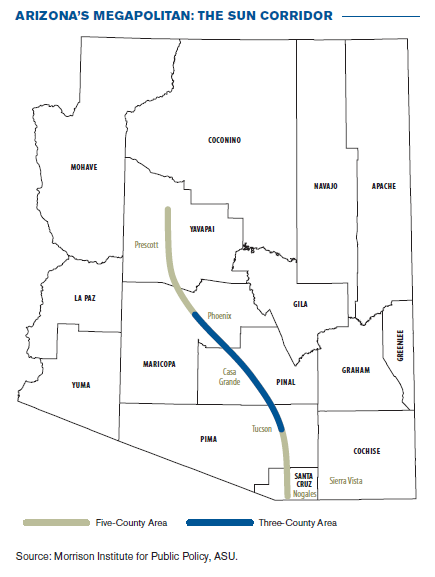
Watering the Sun Corridor – Morrison Institute for Public Policy — “Do we have ample supply for Arizona’s needs today and tomorrow? Are we in a current water crisis? And, if so, what’s being done and what should be done? These questions and more are considered in this Morrison Institute for Public Policy report examining water use, supply and future demand for Arizona’s Sun Corridor – the Central Arizona Urban Region that includes Phoenix and Tucson. The chief author of the report is Senior Research Fellow Grady Gammage, Jr.”
These same Arizona water managers are recommending that Arizonans pay for undelivered water (pay for nothing) by urging Arizona lawmakers to pass legislation on the Arizona Drought Contingency Plan (AZDCP) or Lower Basin Drought Contingency Plan (LBDCP).
This plan will not work because the Colorado River is overallocated. There is no water available for Intentionally Created Surplus (ICS). Creating water by declining water delivery is impossible!
Water stored/conserved through AZDCP or LBDCP will evaporate before it is beneficially used. Paying for undelivered water (paying for nothing) is a total waste of public money . . . The Shell Game!
Reallocating the Colorado River is the only sustainable action available to Colorado River basin states and Mexico!
More Links:


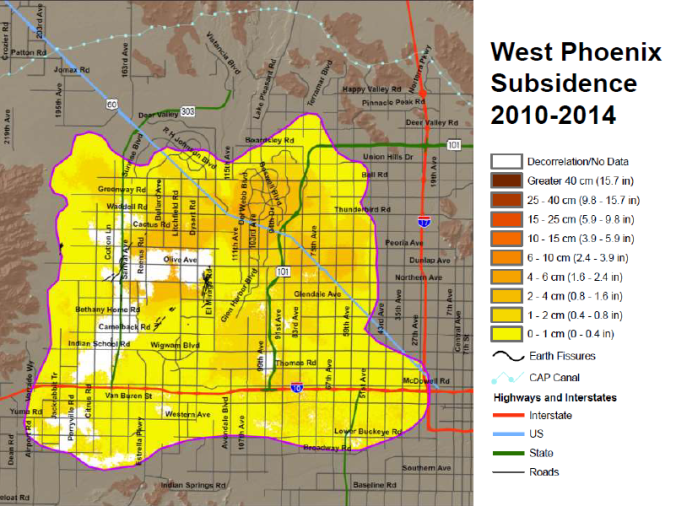
Pingback: AWBA-CAGRD-Banking Water in Arizona | Arizona-Mismanages-Water-Resources
Pingback: ADWR – GMA – AMA – Management Plans Abandoned | Arizona-Mismanages-Water-Resources
Pingback: Maricopa County Domestic Water Use | Arizona-Mismanages-Water-Resources
Pingback: Tribal Drums Disseminate Misinformation | Arizona-Mismanages-Water-Resources